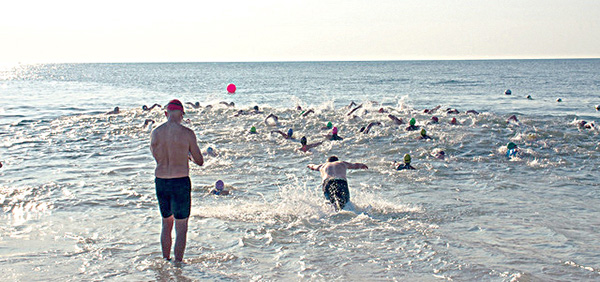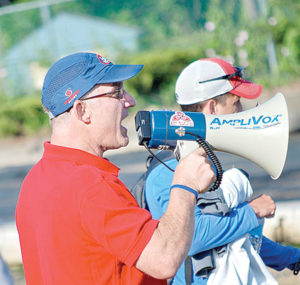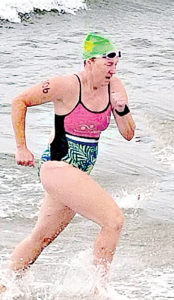BY ART PETROSEMOLO
For generations, children have learned to swim and surf in the waves along New Jersey’s 130 miles of coastline. It is a rite of passage to get tumbled in the surf and rolled onto the beach spitting out saltwater and sand.
Today, those kids are adults and long past summer boogie boarding. Many stay fit as multisport athletes – swimming, running and biking – and compete in triathlon-type events.

Start of the Rooney Ocean Swim in Sea Bright taken in a previous year. This year’s swim is scheduled for Saturday, July 18.
Athletes and coaches agree one of the daunting challenges of triathlons is the initial swim leg that can vary from 300 yards to a mile. Swimming in a chilly, murky ocean against wind, current and waves can be difficult. But mastering the swim is key to being a successful triathlete, explained Erin Glynn, a personal trainer, swim instructor and ocean swimmer from Little Silver.
Long Branch trainer Brian Shea, who coaches open water swimmers and multisport athletes, agrees. He estimated there are more than 1,000 men and women who now train in the ocean during the summer months on a regular basis.
And that number could even be higher. For 2020, there are some 38 triathlons already scheduled in the state, including the New Jersey State Triathlon in Mercer County Park that will attract 3,500 competitors, currently scheduled for July 18 and 19. It is one of the largest in the country. Nationally, triathlons attract more than 4 million participants each year. Most triathletes are between the ages of 30 and 50 with nearly 40 percent being female.

Doug Rice coordinates the Jersey Girls Triathlon and the Rooney Ocean Swim each summer.
At Pier Village in Long Branch, up to 1,800 women compete in the Jersey Girl Triathlon in July and even larger numbers take part in events like The Escape from the Cape Triathlon and Open Water Classic run by DelMo Sports in Cape May.
Multisport athletes take swimming seriously because it isn’t easy. To be a successful swimmer, you must use both arms and legs for propulsion, with coordinated rotary breathing.
There is an understanding among athletes that triathlon-type events are not won in the swim leg, but they can be lost there.
Open Water Swimming (OWS) competitions have become so important for training that in January an online calendar already listed nearly two dozen scheduled ocean swim races in New Jersey and more than 350 nationally. One of the season’s early local races is the Nave-Sink or Swim Distance Festival on the Navesink River which had been scheduled for May 24. Initially postponed to June 14 due to COVID-19 restrictions, it has now been canceled. The next festival will take place May 30, 2021.
OWS got front-page publicity last fall when marathon swimmer Sarah Thomas became the first person to make four consecutive English Channel crossings over 54 hours and 10 minutes. Thomas holds multiple marathon and open water swim records and brought new attention to the sport.
In New Jersey, several training groups along the coast organize weekday open water swim sessions with competitors also participating in weekend races of one mile or longer. And racing in open water here isn’t new. The Andy-Rooney Ocean Swim was started in the 1980s in Sea Bright in memory of Andrew Manning and then-mayor Charlie Rooney and is now organized by his son and current Sea Bright Council president Charlie Rooney. Some 200 swimmers competed in the event in 2019. The Andy-Rooney Ocean Swim is scheduled for July 18 this year.

Trauma surgeon Cathy Dudick, personal trainer and swim instructor Erin Glynn and EMT Candance Brunswick at the end of the Jersey Girls Triathlon.
Doug Rice, an AAU swimmer since age 7 and an All-American college swimmer, runs the Rooney Sea Bright ocean race and has run the Jersey Girls Triathon since 2009. Rice founded Monmouth County’s Sandy Hookers’ Triathlon Club in 1989. It is one of the oldest training groups in the country preparing athletes for multi discipline events.
Rice, 64, helps triathletes get over the fear of open water swimming where, for the first time, many of these athletes face waves and current and not only have trouble breathing comfortably but even lining up the finish line. “Ocean water training for any triathlete is extremely important. Most multisport athletes can run and bike,” he said, “but an open water swim can be intimidating.”
South of Sea Bright, Shea trains athletes for many New Jersey events and serves as the swim trainer for Jersey Girls Triathlon competitors. He works with swimmers year-round. “Ocean training is popular in the summer,” said Shea, “and we run sunrise and sunset training swims off the Long Branch beach with as many as 50 women.” Shea helps swimmers adapt their stroke and breathing to ocean conditions as well as teaching them other OWS techniques including how to sight the target while racing.
Pam Mancuso, Fair Haven, founded the Jersey Shore Tri Gals 12 years ago with Rumson’s Bonnie Cooper. “We regularly have about 60 women in the water off of Anchorage Beach in Sea Bright from June through September for 30 to 45-minute swims. And most participate in a number of multisport events,” she said. Mancuso currently works with Gayle Stamer and Karen Faherty of Little Silver to organize Tri Gals programs.
The Tri Gals do one weekday and one weekend swim during the summer with six lifeguards on surfboards stationed every 100 yards on the course. “We swim through September depending on weather conditions and our members may swim with or without wetsuits,” she said.
Mike Barrows, a Red Bank native, is a pediatric endocrinologist. The 39-year-old is a 30-year ocean water swimmer and has been lifeguarding since age 16. He still finds time to lifeguard part-time at Sea Girt. A triathlon and Ironman competitor, Barrows trains with the New Jersey Race Club, a group that focuses on technique for swimmers who want to succeed in swimming as a competitive sport out of Swim Quest in Tinton Falls. Barrows also trains the Monmouth County lifeguards for the USLA national lifeguard competition. Internationally, open water swim events have been part of the Olympic venue since the Beijing Games in 2008. The 2020 Olympics in Japan now postponed to 2021 is scheduled to include 30 km (nearly 18 mile) races for men and women. Swimming has made quantum leaps during the 20th century. The late Olympic champion Gertrude Ederle and swim coach Terry Laughlin each brought big changes to how people swim competitively some 60 years apart. In 1926, Ederle became the first woman to swim the English Channel. She used the front crawl stroke known today as freestyle for the first time. Freestyle quickly supplanted breaststroke, previously the only stroke used competitively.
In 1989 Laughlin, a former competitive swimmer and coach, introduced a swim program called Total Immersion (TI). TI challenges conventional swimming instruction, applying the basics of hydrodynamics and kinesiology to the sport. He taught swimmers how to be balanced in the water and integrate the body, not just the arms and legs, while conserving energy and enhancing efficiency.

Trainer Erin Glynn leaves the water during a triathlete event.
Trainer Glynn, an experienced TI instructor, open water swimmer and triathlete, sees the results. “TI has found favor with many triathletes who are often more comfortable on land than in water and want to conserve energy for the cycle and running parts of a race,” she said. “They take to TI quickly.”
Statistics show that pool and open water swimming for fitness in the United States continues on an upward trend. In the last 14 years, the sport has attracted some 27 million individuals to the water and the numbers continue to rise.
So, on your next trip to a Jersey beach, look out beyond the surf line and you’ll probably catch a glimpse of ocean swimmers challenging the waves and current with an eye toward a stronger finish in their next triathlon.
The article originally appeared in the June 11 – 17, 2020 print edition of The Two River Times.














